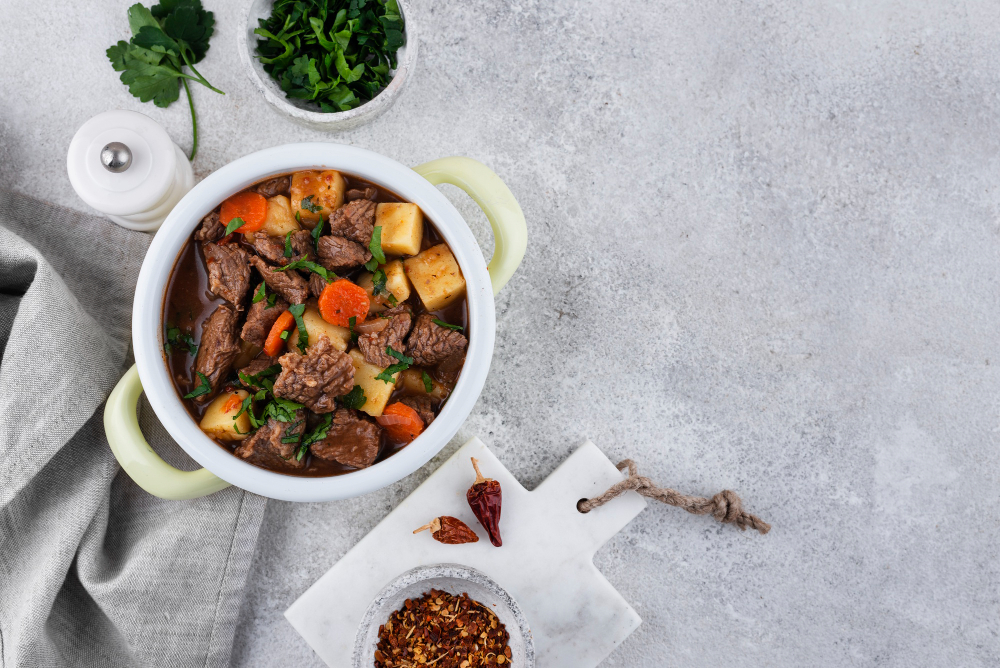Boeuf Bourguignon Recipe Anthony Bourdain
Introduction
Few dishes represent the heart of classic French cuisine as profoundly as boeuf bourguignon. This slow-cooked beef stew, infused with red wine and simmered to perfection, is the epitome of comfort food. While countless chefs have created their versions, none resonate quite like Anthony Bourdain’s boeuf bourguignon recipe from his Les Halles Cookbook.
Bourdain’s take on this dish epitomizes his culinary philosophy: respect for ingredients, simplicity in preparation, and a focus on deep, hearty flavors. His recipe has become a favorite among home cooks and professionals alike. According to Serious Eats’ Classic Les Halles Recipe, Bourdain called this dish “one of the easiest, but best recipes” in his collection.
Understanding the importance of wine selection is vital when preparing this stew. Traditionalists insist on Burgundy wine, which contributes a rich, velvety base. If you’re unsure about which wine to choose, The Spruce Eats’ Guide to Cooking with Red Wine is a valuable resource.
Origins and Cultural Significance of Boeuf Bourguignon
Boeuf bourguignon hails from the Burgundy region in eastern France, an area renowned for its world-class wines and beef-based dishes. Originally a peasant meal, the recipe utilized tough cuts of beef that required long, slow cooking in red wine to achieve tenderness. Over time, this humble stew became a hallmark of French cuisine, elevated to haute cuisine status by chefs such as Julia Child and, later, Anthony Bourdain.
Bourdain’s version is rooted in tradition but stripped of pretension. His goal was to bring bistro-style French cooking to the home kitchen, making braising techniques and bold flavors accessible to everyone.
Anthony Bourdain’s Culinary Philosophy
Bourdain’s approach to food was unapologetically honest. He believed that good food didn’t need to be complicated, but it required respect for ingredients and patience. His work at Les Halles in New York—a bustling French brasserie—taught him the importance of fundamental techniques, especially when it came to braising beef.
Boeuf bourguignon is a dish that demands time and attention. Bourdain’s method emphasizes developing flavor at every step, from searing the meat to slow-cooking it in wine.
Key Ingredients Explained
Each ingredient in Bourdain’s recipe serves a distinct purpose. Understanding their roles can elevate your stew from good to exceptional:
- Beef (Chuck or Shoulder): These tough cuts are rich in collagen, which breaks down during braising, transforming into succulent, fork-tender meat.
- Red Wine (Preferably Burgundy): The soul of the dish, wine adds acidity and depth. Pinot Noir from Burgundy is ideal, but Côtes du Rhône or Cabernet Sauvignon work well too. For more tips, check The Spruce Eats’ Guide to Cooking with Red Wine.
- Mirepoix (Onions, Carrots, Garlic): This aromatic trio forms the foundation of flavor.
- Bacon (Lardons): Adds smokiness and richness. Bourdain’s preference was thick-cut bacon.
- Bouquet Garni: A bundle of thyme, bay leaf, and parsley tied together to infuse herbal notes.
- Pearl Onions & Mushrooms: Contribute sweetness and earthiness, enhancing the stew’s complexity.
Step-by-Step Cooking Process
Preparation: The Importance of Mise en Place
- Cut beef into 1.5-inch cubes, season generously with salt and freshly ground black pepper.
- Peel and chop onions, carrots, and garlic.
- Assemble a bouquet garni with thyme, bay leaf, and parsley.
Browning the Meat: Building the Foundation
- Heat olive oil in a heavy pot over medium heat.
- Sear the beef in batches. Crowding the pan leads to steaming, not browning. A deep brown crust is crucial for flavor.
- Remove beef and sauté bacon until crisp. The rendered fat will enrich the stew.
Developing Flavor Layers
- Sauté onions, carrots, and garlic in bacon fat until soft and aromatic.
- Stir in tomato paste for sweetness and acidity.
- Deglaze with red wine, scraping the pan’s bottom to release caramelized bits (fond).
Braising the Beef
- Return beef to the pot. Add beef stock until meat is just covered.
- Toss in the bouquet garni.
- Cover and simmer low and slow for 2.5 to 3 hours, until beef is tender.
Finishing Touches
- Sauté pearl onions and mushrooms separately until golden.
- Stir into stew before serving.
Expert Cooking Tips
- Wine Quality Matters: As Bourdain famously said, “Don’t cook with wine you wouldn’t drink.”
- Low and Slow: A gentle simmer breaks down collagen into gelatin, creating a silky sauce.
- Rest Overnight: Flavors meld and deepen after resting in the fridge.
Pairing Suggestions
Pair boeuf bourguignon with robust wines like Côtes du Rhône or Cabernet Sauvignon. For sides:
- Crusty French bread to sop up the sauce.
- Buttered noodles or mashed potatoes for a hearty base.
- For a complementary sauce, try this red wine sauce recipe.
Common Mistakes to Avoid
- Skipping Browning: Without a deep sear, the stew lacks depth.
- Cheap Wine: Low-quality wine results in flat flavors.
- Overcrowding the Pot: Leads to steamed meat instead of seared.
- Ignoring Rest Time: Overnight refrigeration enhances flavor.
Variations and Adaptations
- Vegetarian Version: Swap beef for mushrooms and lentils.
- Faster Cooking: Use an Instant Pot.
- Other French Classics: Explore this steak au poivre recipe for another bistro favorite.
Serving and Presentation Ideas
Serve directly from a Dutch oven for a rustic feel, garnished with fresh parsley. Pair with a standing rib roast recipe for a French-inspired feast.
Nutritional Considerations
Approx. 500-600 calories per serving. For a leaner stew, omit bacon or reduce oil.
FAQs
What is the best beef cut? Chuck roast or shoulder.
Can I make it without wine? Substitute beef broth with a splash of balsamic vinegar.
How long to cook? 2.5 to 3 hours for tender beef.
Can it be frozen? Yes, up to 3 months.
Conclusion
Mastering boeuf bourguignon recipe Anthony Bourdain-style is an investment in flavor and tradition. This dish captures the soul of French cooking while honoring Bourdain’s legacy. Take your time, use quality ingredients, and embrace the process. For more hearty French recipes, explore this standing rib roast recipe or this steak au poivre recipe. Happy cooking!

